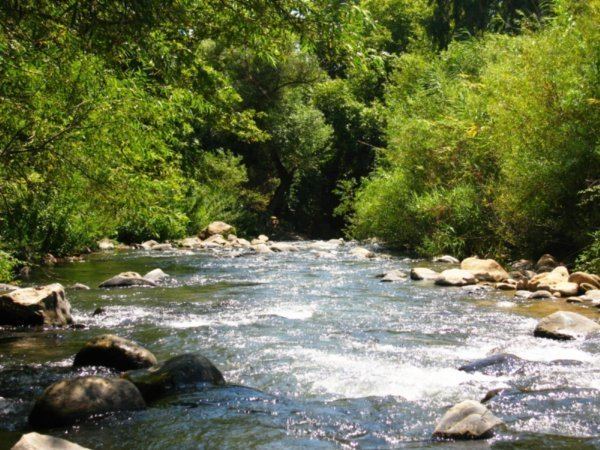Length 65 km | ||
 | ||
The Hasbani River (Arabic: الحاصباني / ALA-LC: al-Ḥāṣbānī; ) or Snir Stream (Hebrew: נחל שניר / Nahal Snir), is the major tributary of the Jordan River. The Hasbani River derives most of its discharge from two springs in Lebanon, the Wazzani and the Haqzbieh, the latter being a group of springs on the uppermost Hasbani. The Hasbani runs for 25 miles in Lebanon before crossing the border at Ghajar and shortly after joining with the Banias and Dan Rivers at a point in northern Israel, to form the River Jordan. For about four kilometers downstream of Ghajar, the Hasbani forms the border between Lebanon and the Golan Heights.
Map of Snir Stream
The Wazzani's and the Haqzbieh's combined discharge averages 138 million m³ per year. About 20% of the Hasbani flow emerges from the Wazzani Spring at Ghajar, close to the Lebanese Israeli border, about 3 kilometers west of the base of Mount Hermon. The contribution of the Wazzani spring is very important, since this is the only continuous year-round flow into the river, in either Lebanon or Israel.
Utilization of water resources in the area, including the Hasbani, has been a source of conflict and was one of the factors leading to the 1967 Six-Day War. The Hasbani was included in the Jordan Valley Unified Water Plan, proposed in 1955 by special US envoy Eric Johnston. Under the plan, Lebanon was allocated usage of 35 million mcm annually from it. The plan was rejected by the Arab League. Instead, at the 2nd Arab summit conference in Cairo of January 1964 the League decided that Syria, Lebanon and Jordan would begin a water diversion project. Syria started the construction of canal to divert the flow of the Banias river away from Israel and along the slopes of the Golan toward the Yarmouk River. Lebanon was to construct a canal from the Hasbani River to Banias and complete the scheme The project was to divert 20 to 30 million cubic metres of water from the river Jordan tributaries to Syria and Jordan for the development of Syria and Jordan. This led to military intervention from Israel, first with tank fire and then, as the Syrians shifted the works further eastward, with airstrikes.
In 2001 the Lebanese government installed a small pumping station with a 10 cm bore to extract water to supply Ghajar village. In March 2002 Lebanon also diverted part of the Hasbani to supply Wazzani village. An action that Ariel Sharon said was a "casus belli" and could lead to war, during the Second Lebanon War the pumping station was destroyed by the Israeli army.
